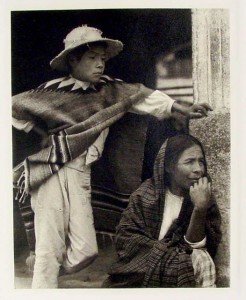Manuel Alvarez Bravo and Paul Strand in the Library Exhibit Cases!
The Library is displaying photographs of Mexico by Manuel Alvarez Bravo and Paul Strand in the central display cases on the main floor of the library.
Manuel Alvarez Bravo (1902-2002) was Mexico’s first principal artistic photographer and is the most important figure in 20th century Latin American photography. He was born and raised in Mexico City. He took art classes at the Academy of San Carlos, but his photography was self-taught. His career formed in the decades after the Mexican Revolution and spanned from the late 1920s to the 1990s, with his artistic peak between the 1920s to the 1950s. His early work was based on European influences, but he was soon influenced by the Mexican muralism movement and the general cultural and political push at the time to redefine Mexican identity. He rejected the picturesque, employing elements to avoid stereotyping. Over his career he had numerous exhibitions of his work, worked in the Mexican cinema, and established Fondo Editorial de la Plastica Mexicana publishing house.
Paul Strand (1890-1976) was an American photographer and filmmaker who, along with fellow modernist photographers like Alfred Stieglitz and Edward Weston, helped establish photography as an art form in the 20th century. His diverse body of work, spanning six decades, covers numerous genres and subjects throughout the Americas, Europe and Africa. From 1932-35, he lived in Mexico and worked on Redes (1936), a film commissioned by the Mexican government, released in the U.S. as The Wave.
The photographs in the first edition of Strand’s Mexican Portfolio were printed from steel-faced gravure plates made in 1940 by master platemaker Otto Wackernagel. The photographs presented in the Harold F. Johnson Library are from Paul Strand: The Mexican Portfolio, 2nd Edition, 1967. They were printed by Albert DeLong from the original plates.

American (1890-1976)
Woman and Boy, Tenancingo
1933
Photograph
HC 1031.009
From the Hampshire College Collection
-On Display during Regular Library Hours-
